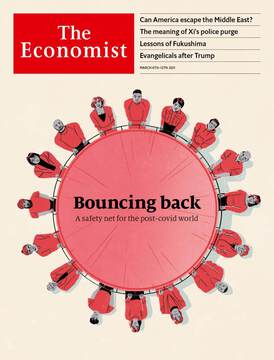
本期经济学人杂志【经济金融】板块下这篇题为《With growth on track, China starts to unwind stimulus》的文章关注的是随着疫情得到有效控制,中国经济逐步复苏,在疫情防控常态化下为保证经济平稳发展财政和货币政策可能逐步收紧。
作为最早受到疫情影响的国家,中国是全球首个启动信贷和支出刺激的国家,随着经济逐步复苏,现在也第一个开始收紧刺激政策。由于中国早在一年前就安排工人安全有序地回到工作岗位,因此相比其他国家中国推出的刺激政策并不算多。
文章认为,中国收紧刺激政策最显著的方面在于它的“渐进性”。李克强总理在两会期间公布的 2021 年预算赤字率由去年的 3.6% 调降至 3.2%(译注:市场预期是 3%)。根据摩根士丹利的分析,如果把有政府背景的企业的刺激支出算上的话,中国今年的实际预算赤字率为 12%,相比去年创纪录的 15% 有所下降,但仍高于 2019 年的 10%。
中国央行也谨慎操作,通过调控流动性引导市场利率和减少银行信贷。有分析师认为,“十四五”规划中的基础建设等投资支出可能部分抵消刺激政策的收紧效应。
虽然市场预期今年中国的经济增长率可能达到 8-9%,但中国依然设置了一个 “6%以上” 的经济增长目标。文章认为,这一目标虽然保守但能为可能的疫情反弹和经济过热状况预留调整空间,如果政府将经济增长目标定为 9%,这会让市场认为政府收紧刺激政策并非认真。
文章最后认为,让政策保持灵活性是明智的。
With growth on track, China starts to unwind stimulus
Taper test
With growth on track, China starts to unwind stimulus
Its exit will offer a partial preview for others
Finance & economics
Mar 6th 2021 edition
Mar 6th 2021
SHANGHAI
This article has been updated
THE PHRASE “first in, first out” has become shorthand for China’s experience of the covid-19 pandemic: it is both where the virus started spreading and the first large country to control it. Its early failure and subsequent success will be studied by epidemiologists for years to come. But for economists and investors, it is another “first in, first out” that matters more at the moment. China was the first country to open its lending and spending taps in the face of the coronavirus downturn. Now, it is the first to start to close them, giving others a partial preview of what the end of stimulus will look like.
Parallels between countries are, of course, imperfect. China, for one, required less stimulus to begin with, because its workers went back to factories and offices nearly a full year ago. But a few general conclusions can still be drawn about its return to more normal monetary and fiscal policies. At the National People’s Congress, an annual rubber-stamp parliament that began on March 5th, China’s leaders laid out their basic roadmap.
The most notable aspect is its gradualism. At the opening of the congress, Li Keqiang, China’s prime minister, announced that China would target a fiscal deficit of 3.2% of GDP this year, down from last year’s 3.6%. Factoring in other quasi-fiscal measures such as spending by government-linked companies, China’s true fiscal deficit will be about 12% of GDP, compared with a record high of 15% last year, according to Morgan Stanley, a bank. That is a retrenchment, but still higher than its deficit in 2019, of roughly 10% of GDP.
The central bank has also been cautious. It has withdrawn liquidity to guide up market interest rates and to slow the growth in bank lending. But both the price and quantity of credit remain more generous than before the pandemic struck. “They are aiming to avoid a sharp turn in the policy orientation,” says Zhu Ning of the Shanghai Advanced Institute of Finance. With 2021 marking the start of a new five-year plan for China, officials will be racing to launch infrastructure projects. The new plan—an important part of the policy process in China—promises big expansions of railways, power lines and more. That, Mr Zhu says, should help offset the end of the coronavirus stimulus.
The tightening, however gradual, is bound to be bumpy. In the past couple of weeks global markets have been roiled by the rise in Treasury yields in America. China went through a similar squeeze in late January when the central bank was far stingier in its open-market operations than expected, leading to a spike in overnight borrowing rates. Stocks fell sharply, though recovered when the central bank eased up. Officials may have wanted to put investors on notice. They have also sounded warnings about asset prices. On March 2nd Guo Shuqing, the top banking regulator, warned of bubbles in the Chinese property market and global financial markets.
As well as China has done in taming covid-19, its policy normalisation still depends on the course of the pandemic globally. Domestic travel remains limited amid lingering concerns about the virus and international travel is largely blocked. A slow roll-out of vaccines in China means there is no chance that it will fling open its doors to the world soon.
Nevertheless, given how rough last year was, China’s rebound is likely to be big—something else that other countries will also enjoy. Many analysts think growth could be as high as 9% in 2021, up from last year’s 2.3%. But the government is, publicly at least, setting its sights lower. In his address to the congress, Mr Li said that China would aim for growth above 6% this year.
Barring any major setbacks, that should be easy to achieve. Even with quarter-on-quarter growth of zero for the rest of this year, China would still reach 6% year-on-year growth for 2021 as a whole. That is thanks to the combined effect of its strong performance at the end of 2020 and a very low base of comparison for the first half of the year (growth in the first quarter of 2021 is, for example, expected to soar to nearly 20% compared with a year earlier, when the country was in lockdown for part of the time). The target of 6% growth is thus conservative. It leaves China plenty of wiggle room if the pandemic proves stubborn, and plenty of scope to taper further if the economy heats up. After all the troubles of the past year, it makes sense to be flexible. ■
This article appeared in the Finance & economics section of the print edition under the headline"Taper test"
